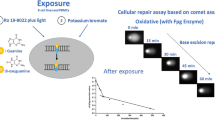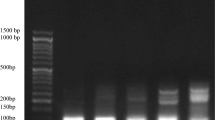Abstract
Total repair capability is a widely used phenotypic marker of predisposition to cancer. Evaluation of this parameter implies using a challenge mutagen in an in vitro system to unmask latent genetic instability and repair insufficiency in the target cells. Traditionally, these investigations involve two tests, evaluation of mutagenic susceptibility (chromosomal aberrations) and genotoxic effect (DNA comet assay). The present study was focused on analysis of the effect of methylnitrosourea (MNU) on resting and PHA-stimulated lymphocytes from healthy donors and patients with gynecological cancer. Cytotoxic effect of MNU (apoptotic lymphocyte death) was estimated using two parameters, interaction of the cells with the annexin V-FITC complex, and morphological changes of the nuclei after their staining with the mixture of two DNA-tropic dyes. The genotoxic effect of MNU, namely, secondary double-strand DNA breaks, was scored using the neutral comet assay, modified for the calculation of the comets produced exclusively by BrUdr-labeled proliferating lymphocytes. The proportion of these comets was represented as the proliferative cell index. It was shown that resting lymphocytes were resistant to genotoxic and cytotoxic effects of MNU. The response of proliferating cells to the action of MNU was expressed as the development of secondary DNA breaks (P < 0.01), along with the increased frequency of apoptosis (P < 0.05). The genotoxic effect of MNU on stimulated lymphocytes of gynecological cancer patients was fourfold lower compared to healthy donor lymphocytes. In response to the MNU action, patient lymphocytes did not change their proliferative index, while in healthy donor lymphocytes proliferative index was two times decreased in response to the MNU action. The data obtained pointed to the association between the cytotoxic response of the lymphocytes to the action of MNU and gynecological cancer. Since only proliferating lymphocytes response to the genotoxic effect of MNU, and the effect is revealed a day after the mutagen action, it is suggested that this phenomenon is associated with postreplicative repair, MMR, the substrate of which is O6-methylguanin. The MMR deficiency in patient lymphocytes determines their tolerance to the action of MNU. Genotoxic response of lymphocytes to the action of MNU can serve as a marker of MMR, as well as of the MMR deficiency-associated gynecological cancer.
Similar content being viewed by others
References
Vogelstein, B. and Kinzler, K.W., Cancer Genes and the Pathways They Control, Nat. Med., 2004, vol. 10, pp. 789–799.
Berwick, M. and Vineis, P., Markers of DNA Repair and Susceptibility to Cancer in Humans: An Epidemiologic Review, J. Natl. Cancer Inst., 2000, vol. 92, pp. 874–897.
Hsu, T.C., Genetic Instability in the Human Population: A Working Hypothesis, Hereditas, 1983, vol. 98, pp. 1–9.
Hsu, T.C., Johnston, D.A., Cherry, L.M., et al., Sensitivity to Genotoxic Effects of Bleomycin in Humans: Possible Relationship to Environmental Carcinogenesis, Int. J. Cancer, 1989, vol. 43, pp. 403–409.
Peltomaki, P., Role of DNA Mismatch Repair Defects in the Pathogenesis of Human Cancer, J. Clin. Oncol., 2003, vol. 21, pp. 1174–1179.
Drake, A.C., Campbell, H., Porteus, M.E.M., and Dunlop, M.G., The Contribution of DNA Mismatch Repair Gene Defects to the Burden of Gynecological Cancer, Int. J. Gynecol. Cancer, 2003, vol. 13, pp. 262–277.
Schottenfeld, D., Epidemiology of Endometrial Neoplasia, J. Cell Biochem., 1995, vol. 23,suppl., pp. 151–159.
Thipgen, J.T., Chemotherapy of Advanced Ovarian Cancer, Semin. Oncol., 2000, vol. 7, pp. 11–16.
Miturski, R., Bogusiewicz, M., Ciotta, C., et al., Mismatch Repair Genes and Microsatellite Instability as Molecular Markers for Gynecological Cancer Detection, Exptl. Biol. Med. (Maywood, NJ, U.S.), 2002, vol. 227, pp. 579–586.
Taverna, P., Liu, L., Hanson, A.J., et al., Characterization of MLH1 and MSH2 DNA Mismatch Repair Proteins in the Cell Lines of the NCI Anticancer Drug Screen, Cancer Chemother. Pharmacol., 2000, vol. 46, pp. 507–516.
Tronov, V.A., Kramarenko, I.I., and Terekhov, S.M., Comparison of Geno-and Cytotoxicity of Methylnitrosourea on MMR-Proficient and MMR-Deficient Human Tumor Cell Lines, Tsitologiya, 2006, vol. 48, pp. 19–27.
Tronov, V.A., Kramarenko, I.I., Maiorova, E.N., and Zakharov, S.F., Mismatch Repair (MMR) Efficiency and MSH2 Gene Mutation in Human Colorectal Carcinoma Line SOLO32OHSR, Rus. J. Genet., 2007, vol. 43, pp. 430–436.
Konca, K., Lankoff, A., Banasik, A., et al., A Cross-Platform Public Domain PC Image-Analysis Program for the Comet Assay, Mutat. Res., 2003, vol. 534, pp. 15–20.
Holley, W.R., and Chatterjee, A., Clusters of DNA Induced by Ionizing Radiation: Formation of Short DNA Fragments: I. Theoretical Modeling, Radiat. Res., 1996, vol. 145, pp. 188–199.
Kaina, B. and Christmann, M., DNA Repair in Resistance to Alkytlating Anticancer Drugs, Int. J. Clin. Pharm. Ther., 2002, vol. 40, pp. 354–367.
Mayer, C., Popanda, O., Zelezny, O., et al., DNA Repair Capacity after Gamma-Irradiation and Expression Profiles of DNA Repair Genes in Resting and Proliferating Human Peripheral Blood Lymphocytes, DNA Repair., 2002, vol. 1, pp. 237–250.
Tronov, V.A., Konstantinov, E.M., and Kramarenko, I.I., Role of Excision Mechanisms of DNA Repair in Induction of Apoptosis, Biochemistry (Moscow), 2002, vol. 67, pp. 730–736.
Tatsuka, M., Ibeanu, G.C., Izumi, T., et al., Structural Organization of the Mouse DNA Repair Gene, N-Methylpurine-DNA Glycosylase, DNA Cell Biol., 1995, vol. 14, pp. 37–45.
Major, G.N. and Collier, J.D., Repair of DNA Lesion O6-Methylguanine in Hepatocellular Carcinogenesis, J. Hepatobiliary Pancreat. Surg., 1998, vol. 5, pp. 355–366.
Bignami, M., O’Driscoll, M., Aquilina, G., and Karran, P., Unmasking a Killer: DNA O6-Methylguanine and the Cytotoxicity of Methylating Agents, Mutat. Res., 2000, vol. 462, pp. 71–82.
Ochs, K. and Kaina, D., Apoptosis Induced by DNA Damage O6-Methylguanine Is Bcl-2 and Caspase-9/-3 Regulated and Fas/Caspase-8 Independent, Cancer Res., 2000, vol. 60, pp. 5815–5824.
Parsons, R., Li, G.M., Longley, M.J., et al., Hypermutability and Mismatch Repair Deficiency in RER+ Tumor Cells, Cell, 1993, vol. 75, pp. 1227–1236.
Gifford, G., Paul, J., Vasey, P.A., et al., The Acquisition of HMLH1 Methylation in Plasma DNA after Chemotherapy Predicts Poor Survival for Ovarian Cancer Patients, Clin. Cancer Res., 2004, vol. 10, pp. 4420–4426.
Author information
Authors and Affiliations
Corresponding author
Additional information
Original Russian Text © V.A. Tronov, M.J. Loginova, I.I. Kramarenko, 2008, published in Genetika, 2008, Vol. 44, No. 5, pp. 686–692.
Rights and permissions
About this article
Cite this article
Tronov, V.A., Loginova, M.J. & Kramarenko, I.I. Methylnitrosourea as challenge mutagen in assessment of the DNA mismatch repair (MMR) activity: Association with some types of cancer. Russ J Genet 44, 595–600 (2008). https://doi.org/10.1134/S1022795408050128
Received:
Accepted:
Published:
Issue Date:
DOI: https://doi.org/10.1134/S1022795408050128




